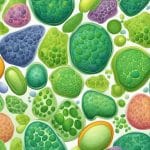Types Of Passive Transport
Passive transport is a type of cellular transport that does not require the expenditure of energy by the cell. It occurs spontaneously and is driven by the concentration gradient between the extracellular and intracellular environments. Passive transport is an essential process for maintaining cellular homeostasis and is involved in a wide range of physiological processes.
There are four main types of passive transport: simple diffusion, facilitated diffusion, filtration, and osmosis. Simple diffusion involves the movement of small, nonpolar molecules across the cell membrane from an area of high concentration to an area of low concentration. Facilitated diffusion, on the other hand, involves the movement of larger, polar molecules across the membrane with the help of transport proteins. Filtration occurs when molecules are forced across the membrane by hydrostatic pressure, while osmosis is the movement of water across the membrane from an area of low solute concentration to an area of high solute concentration.
Understanding the different types of passive transport is important for comprehending cellular physiology and the processes that occur within living organisms. By understanding the fundamental principles of passive transport, researchers and clinicians can gain insight into the mechanisms underlying disease and develop new treatments to improve patient outcomes.
Key Takeaways
- Passive transport is a type of cellular transport that occurs spontaneously and does not require the expenditure of energy by the cell.
- There are four main types of passive transport: simple diffusion, facilitated diffusion, filtration, and osmosis.
- Understanding the different types of passive transport is essential for comprehending cellular physiology and developing new treatments to improve patient outcomes.
Fundamentals of Passive Transport

Passive transport is a naturally occurring process that requires no energy from the cell to accomplish the movement of molecules across the membrane. This process occurs when molecules move from an area of high concentration to an area of low concentration. The concentration gradient is the driving force for passive transport.
Diffusion
Diffusion is the most direct form of passive transport. It is the net movement of molecules from an area of high concentration to an area of low concentration. This movement occurs until equilibrium is reached. Equilibrium is the state at which the concentration of a substance is equally distributed throughout a space.
The rate of diffusion is influenced by several factors, including the size of the molecule, temperature, and concentration gradient. Smaller molecules diffuse more rapidly than larger molecules. Higher temperatures increase the kinetic energy of the molecules, leading to faster diffusion. A steeper concentration gradient leads to faster diffusion.
Osmosis
Osmosis is the passive transport of water molecules across a selectively permeable membrane. Water molecules move from an area of high concentration to an area of low concentration until equilibrium is reached. The concentration of solutes on either side of the membrane determines the direction of water movement.
In summary, passive transport is a naturally occurring process that moves molecules from an area of high concentration to an area of low concentration. The concentration gradient is the driving force for this process. Diffusion is the most direct form of passive transport, while osmosis is the passive transport of water molecules across a selectively permeable membrane.
Types of Passive Transport
Passive transport is the movement of molecules across a cell membrane from an area of higher concentration to an area of lower concentration without the use of energy. There are three main types of passive transport: simple diffusion, facilitated diffusion, and filtration.
Simple Diffusion
Simple diffusion is the movement of small, uncharged molecules such as oxygen, carbon dioxide, and nitrogen across the cell membrane. The movement of these molecules occurs down their concentration gradient, from an area of high concentration to an area of low concentration. The process of simple diffusion does not require any protein channels or transporters and is solely dependent on the concentration gradient.
Facilitated Diffusion
Facilitated diffusion is the movement of larger, charged molecules such as glucose and amino acids across the cell membrane. The process of facilitated diffusion requires the presence of a protein channel or transporter to facilitate the movement of molecules across the membrane. The protein channel or transporter provides a pathway for the molecules to move across the membrane, allowing them to move down their concentration gradient.
Filtration
Filtration is the movement of water and small solutes across a membrane due to hydrostatic pressure. This process occurs in the kidneys, where blood is filtered to remove waste products and excess water. The process of filtration is dependent on the size of the solutes and the pressure gradient across the membrane.
In summary, passive transport is an essential process that allows molecules, ions, and water to enter and exit cells without the need for energy. Simple diffusion, facilitated diffusion, and filtration are the three main types of passive transport, each with its specific mechanism for movement across the cell membrane. The protein channels and transporters play a crucial role in facilitating the movement of molecules across the membrane, allowing cells to maintain homeostasis.
Membrane Characteristics and Transport
Permeability
The plasma membrane is a selectively permeable membrane that allows certain substances to pass through while restricting others. The membrane’s permeability is determined by its composition. The phospholipid bilayer is composed of hydrophobic tails and hydrophilic heads. The hydrophobic tails face each other, creating a nonpolar environment that prevents the passage of polar molecules and ions. On the other hand, the hydrophilic heads face outward, creating a polar environment that allows the passage of small, nonpolar molecules.
Selective Permeability
The plasma membrane’s selective permeability is also determined by the presence of transport proteins. These proteins help to move substances across the membrane that cannot pass through the phospholipid bilayer. There are two types of transport proteins: channel proteins and carrier proteins. Channel proteins form channels in the membrane that allow specific substances to pass through, while carrier proteins bind to specific substances and transport them across the membrane.
The plasma membrane’s selective permeability is critical for the cell’s survival, as it allows the cell to maintain a stable internal environment. Without this selectivity, the cell would be unable to regulate the movement of substances in and out of the cell, leading to cell death.
In summary, the plasma membrane is a selectively permeable membrane that allows certain substances to pass through while restricting others. The membrane’s permeability is determined by its composition, which includes the phospholipid bilayer and transport proteins. The membrane’s selective permeability is critical for the cell’s survival, as it allows the cell to maintain a stable internal environment.
Role of Transport Proteins
Passive transport is a type of cellular transport that does not require energy expenditure by the cell. Transport proteins play a vital role in passive transport, allowing ions and molecules to cross the cell membrane. Transport proteins are membrane proteins that form channels or carriers that facilitate the diffusion of molecules across the cell membrane.
Channel Proteins
Channel proteins are transport proteins that form a pore or channel through the membrane. These channels are selective and only allow specific ions or molecules to pass through. The selectivity of channel proteins is determined by the size, shape, and charge of the molecule. Ion channels are a type of channel protein that allows ions to cross the cell membrane. Aquaporins are another type of channel protein that allows water molecules to cross the cell membrane.
Carrier Proteins
Carrier proteins are transport proteins that bind to specific molecules and transport them across the membrane. These proteins undergo a conformational change when they bind to the molecule, allowing the molecule to be transported across the membrane. Carrier proteins are specific to the molecule they transport and can transport molecules in both directions across the membrane.
Transport proteins play an essential role in maintaining the concentration gradient across the cell membrane. They allow molecules to move from areas of high concentration to areas of low concentration, ensuring that the cell maintains homeostasis. Channel proteins and carrier proteins are two types of transport proteins that facilitate passive transport across the cell membrane.
Physiological Implications of Passive Transport
Passive transport is a critical process for maintaining homeostasis in living organisms. It is responsible for the movement of various substances across the cell membrane, including ions, vitamins, and hormones. The following subsections discuss the physiological implications of passive transport.
Homeostasis
Homeostasis is the maintenance of stable internal conditions within an organism. Passive transport plays a crucial role in this process by allowing the movement of ions across the cell membrane. For example, potassium ions move passively out of the cell, while sodium ions move passively into the cell. This movement of ions helps to maintain the electrochemical gradient across the cell membrane, which is essential for various physiological processes, including nerve impulses and muscle contractions.
Cellular Communication
Passive transport is also involved in cellular communication. The movement of neurotransmitters across the synapse is an example of passive transport. Neurotransmitters are released from the presynaptic neuron and move passively across the synapse to bind to receptors on the postsynaptic neuron. This process is essential for the transmission of nerve impulses and the regulation of various physiological processes.
Passive transport also plays a role in the movement of hormones across the cell membrane. Hormones are released from endocrine glands and move passively across the cell membrane to bind to receptors on target cells. This process is essential for the regulation of various physiological processes, including metabolism, growth, and reproduction.
In conclusion, passive transport is a critical process for maintaining homeostasis and cellular communication in living organisms. It plays a crucial role in the movement of various substances across the cell membrane, including ions, vitamins, and hormones. Understanding the physiological implications of passive transport is essential for understanding the various physiological processes that occur in living organisms.






